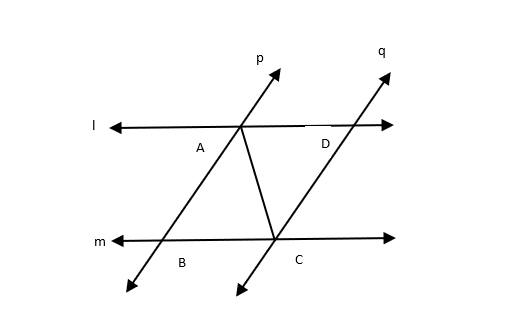
Answer
482.4k+ views
Hint- Use the properties of similarity of triangles.
Given: $l\parallel m$ and $p\parallel q$
Taking $l\parallel m$ and $AC$ is the traversal,
$\angle ACB = \angle CAD{\text{ }} \ldots \ldots \left( 1 \right){\text{ }}\left( {\because {\text{Alternate angles}}} \right)$
Considering $p\parallel q$ and $AC$ is the traversal,
$\angle BAC = \angle DCA{\text{ }} \ldots \ldots \left( 2 \right){\text{ }}\left( {\because {\text{Alternate angles}}} \right)$
In $\Delta ABC$ and $\Delta CDA$:
$
\angle ACB = \angle CAD{\text{ }}\left( {{\text{from }}\left( 1 \right)} \right) \\
AC = CA {\text{ }}\left( {{\text{common}}} \right) \\
\angle BAC = \angle DCA{\text{ }}\left( {{\text{from }}\left( 2 \right)} \right) \\
$
Therefore, using ASA congruence rule, we can say:
${\text{ }}\Delta ABC \cong \Delta CDA$
Hence Proved.
Note- When two triangles are congruent, they will have exactly the same three sides and exactly the same three angles. Although these equal sides and angles may not be at the exact same position. Also, there are criteria like SAS, ASA, SSS to prove triangles are congruent
Given: $l\parallel m$ and $p\parallel q$
Taking $l\parallel m$ and $AC$ is the traversal,
$\angle ACB = \angle CAD{\text{ }} \ldots \ldots \left( 1 \right){\text{ }}\left( {\because {\text{Alternate angles}}} \right)$
Considering $p\parallel q$ and $AC$ is the traversal,
$\angle BAC = \angle DCA{\text{ }} \ldots \ldots \left( 2 \right){\text{ }}\left( {\because {\text{Alternate angles}}} \right)$
In $\Delta ABC$ and $\Delta CDA$:
$
\angle ACB = \angle CAD{\text{ }}\left( {{\text{from }}\left( 1 \right)} \right) \\
AC = CA {\text{ }}\left( {{\text{common}}} \right) \\
\angle BAC = \angle DCA{\text{ }}\left( {{\text{from }}\left( 2 \right)} \right) \\
$
Therefore, using ASA congruence rule, we can say:
${\text{ }}\Delta ABC \cong \Delta CDA$
Hence Proved.
Note- When two triangles are congruent, they will have exactly the same three sides and exactly the same three angles. Although these equal sides and angles may not be at the exact same position. Also, there are criteria like SAS, ASA, SSS to prove triangles are congruent
Recently Updated Pages
How many sigma and pi bonds are present in HCequiv class 11 chemistry CBSE

Mark and label the given geoinformation on the outline class 11 social science CBSE

When people say No pun intended what does that mea class 8 english CBSE

Name the states which share their boundary with Indias class 9 social science CBSE

Give an account of the Northern Plains of India class 9 social science CBSE

Change the following sentences into negative and interrogative class 10 english CBSE

Trending doubts
Fill the blanks with the suitable prepositions 1 The class 9 english CBSE

The Equation xxx + 2 is Satisfied when x is Equal to Class 10 Maths

In Indian rupees 1 trillion is equal to how many c class 8 maths CBSE

Which are the Top 10 Largest Countries of the World?

How do you graph the function fx 4x class 9 maths CBSE

Give 10 examples for herbs , shrubs , climbers , creepers

Difference Between Plant Cell and Animal Cell

Difference between Prokaryotic cell and Eukaryotic class 11 biology CBSE

Why is there a time difference of about 5 hours between class 10 social science CBSE




